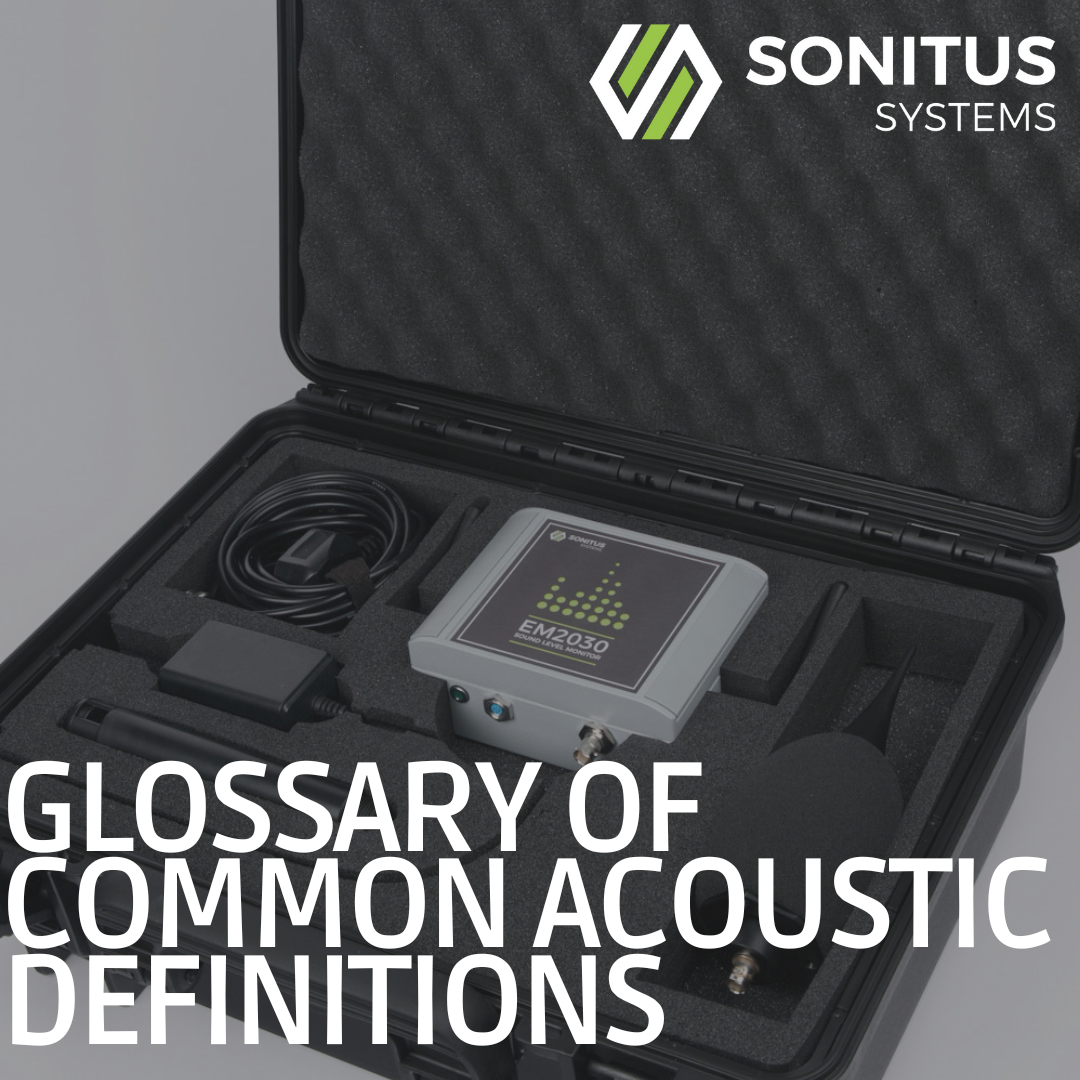In the world of acoustics there are countless terms and parameters, each used for different applications. Sonitus Systems noise measurement products are mainly focused on environmental monitoring in applications such as construction & demolition, industry, hospitality (e.g. music festivals) and smart buildings. In this glossary the most important and common parameters used in these types of applications are explained.
Frequency Weighting
The human ear is most sensitive to frequencies between 500Hz and 6kHz and are less sensitive to frequencies above and below these. We use frequency weightings to represent what humans hear. These are filters that adjust the raw data on different frequency bands. Our Sound Level monitors automatically apply this filter. The most used frequency weightings are ‘A’, ‘C’ and ‘Z’. The frequency weightings used on a sound level metre are defined in IEC 61672:2003 (BS EN 61672-1:2003).
‘A’ Frequency Weighting
The ‘A’ weighting filter covers the full frequency range from 20Hz to 20kHz. The filter adjusts the result per frequency band to represent the sensitivity response of the human ear. A-weighting measurement results are shown in dB(A), e.g. LAeq or LAFmax.
‘C’ Frequency Weighting
This is a standard weighting of the audible frequencies commonly used for the measurement of Peak Sound Pressure level. C-weighting measurement results are shown in dB(C), e.g. LCeq or LCPeak.
‘Z’ Frequency Weighting
This is a flat and unadjusted frequency response between 10 Hz and 20kHz. Z-weighting measurement results are shown in dB(Z), e.g. LZeq or LZFmax.
The chart below shows the level adjustment per frequency band for different weightings.
Time Weighting
Sound levels measurements can be fast, slow or impulse time weighted, referring to the number of samples taken.
- Fast corresponds to a 125-millisecond time constant, meaning 8 samples per second are taken.
- Slow corresponds to a 1 second time constant, meaning 1 sample per second is taken.
- Impulse corresponds to a 35-millisecond time constant, meaning approximately 28 samples per second are taken.
The faster the time constant the more data, the ‘more accurate’ the result. Nowadays most digital metres will measure either Fast or Slow, with Impulse being rarely used.
Average Noise Level, Leq, Leq,t or LAeq,t
The Leq is the equivalent continuous sound level, or the average sound level over the period of the measurement. The settled steady value makes it much easier to read accurately than with a simple instantaneous sound level (SPL). Because it is an average the Leq shows the total energy being measured making it a better indicator for investigating complaints of potential health and safety issues. Usually measurements are A-weighted (link to above).
The ’t’ determine the time period of which the average is taken. Often it also needs to be specified what hours, for example. LAeq,10h from 8am to 6pm on Monday is the average A-weighted noise level from 8am to 6pm on Monday.
Min, Max and Peak
The maximum and minimum are simply the highest and lowest sound levels measured in a certain time period, with a time constant applied (fast or slow). The Peak is not the same as the Maximum Sound Level. The Peak, referred to as the Lpeak or sometimes Lpk, is the maximum value reached by the sound pressure (no time constant applied).
Octave and Third Octave Band Filters
Every measurement result is the overall result from energy out of different frequency bands. A metre with these filters splits the spectrum into around 10 (for octave) or 30 (for 1/3 octave) bands, giving the ability to determine the frequency content of the noise. This can help when assessing very tonal noise. Octave band measurements give an accurate method for calculating the level at the ear when wearing hearing protectors.
The Octave Bands show the build-up of the measurement result over 10 different frequencies. The centre frequencies for these bands are usually:
31.5Hz, 63Hz, 125Hz, 250Hz, 500Hz, 1kHz, 2kHz, 4kHz, 8kHz and 16kHz
Third Octave Band Filters are very similar to the Octave Band filters. The difference is that each of the Octave Bands is split into three, giving a more detailed description of the frequency content of the noise.
The sound level metre will measure the noise in each of the spectrum bands, either all at the same time (real-time or parallel filters) or switching to one band at a time (serial filters). This can be very helpful if you were trying to reduce the noise levels as you can see on what frequency band you need to focus.
Statistics or Ln
Statistics show the noise level that is exceeded for a certain percentage of the time, ‘n’ being the percentage. Different statistics are used to express different applications and events.
For example,
- L10, the noise level exceeded for 10% of the measurement period. Commonly used for traffic noise. An a-weighting can be applied (LA10).
- L90, the noise level exceeded for 90% of the measurement period. Commonly used to determine the ambient or background noise level.
Calibration
This is a (manual) process of checking a noise metre by applying a known signal level and frequency to verify if the metre is operating (responding) correctly in the field. This task is usually performed prior to use of the noise metre. Any drift from the nominal reading can be corrected prior deployment. If the drift is more than +0.2dB it usually means something is wrong with the microphone or the unit and it cannot be used.
A field calibrator is used for these types of performance checks. Calibrators usually create a tone at 94 or 114dB at a frequency of 1kHz.
Sonitus Systems offers both the hardware and software for a range of environmental parameters on a continual basis, with real-time information available through our Sonitus Cloud dashboard. For more details on our indoor and outdoor noise and air quality monitoring products and services, please contact the team athttps://www.sonitussystems.com/contact-us
